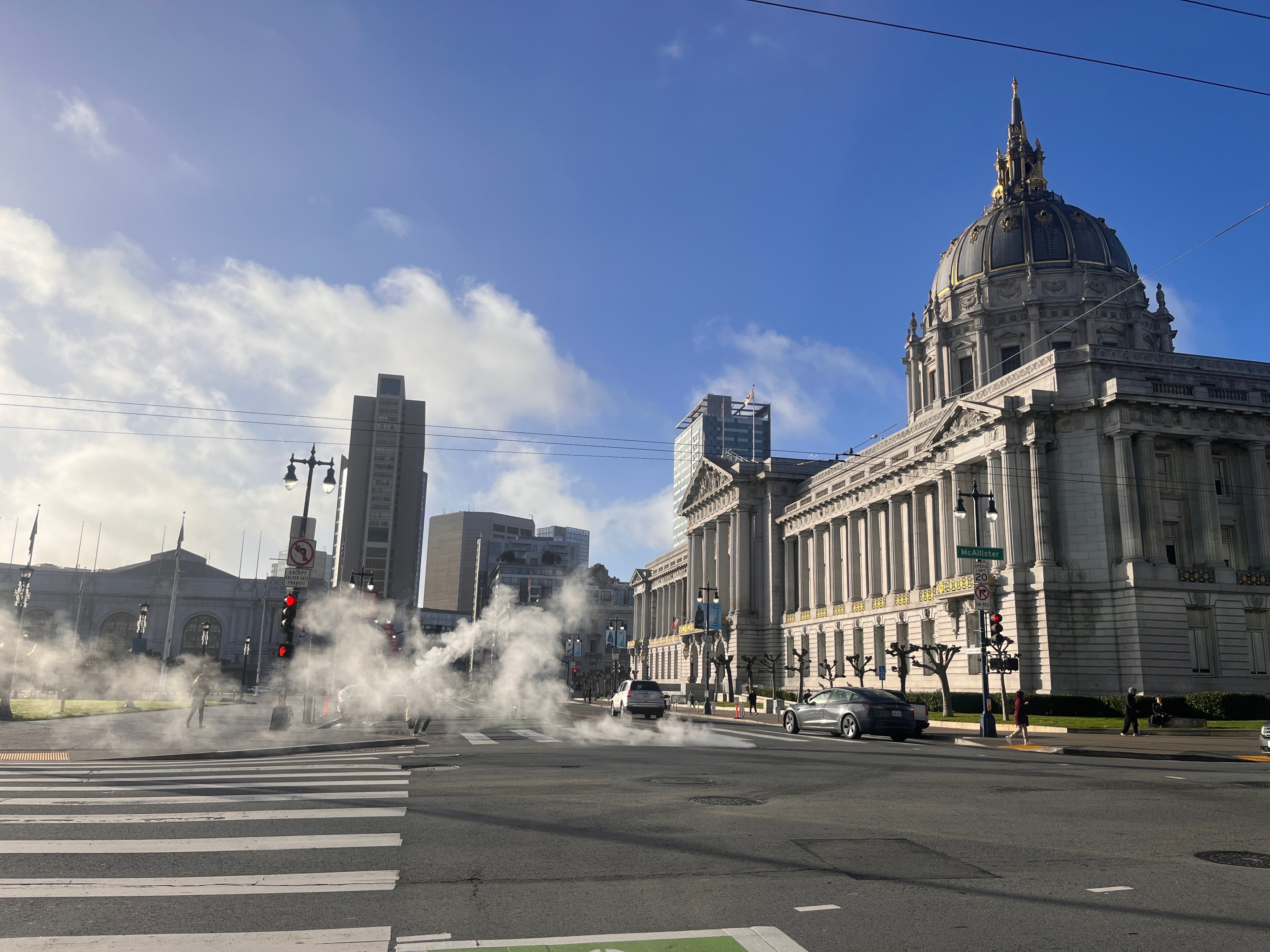Walking around Downtown San Francisco, you’ve probably seen clouds of steam rising up from manholes and gusting along city streets. By City Hall, you might have seen homeless people camping nearby to stay warm—but where is the steam coming from, and what is its actual purpose?
Arguably, it’s the city’s third most famous cloud formation, after Karl the Fog and Golden Gate Park’s 4/20 billowing. We even had a famous local beer with steam in its name, until recently.
One Standard reader wanted to know why steam continues to waft out of city streets. As one Redditor asked earlier this month: What’s down there and why is it angry?
Steam has been an integral part of the city’s infrastructure since around seven years after the 1906 earthquake—a period when the city massively overhauled its infrastructure after earthquake damage. Steam heats some of its most important buildings from City Hall to the public library and health department, according to Mike Eurkus who manages the majority of San Francisco’s steam heating network for Cordia Energy—a third-party company hired by the city.
Cordia runs a two-square-mile district heating system for the city: The system takes groundwater from beneath Powell BART Station and pipes it for filtration and treatment before heating it at two boilers at 460 Jessie St. (behind the new Ikea) and 1 Meacham Place (at Hyde and Post streets).
The boilers, fueled by either natural gas or diesel fuel, create steam, which then travels along a 71,540-foot distribution network to about 180 different buildings, providing heat for more than 37 million square feet of office space in the Tenderloin, Union Square, the Financial District and parts of SoMa.
According to a Department of Public Works newsletter, feeder pipes run steam from the network into radiators that heat San Francisco City Hall. When the loop opened in 1915, a powerhouse at Larkin and McAllister streets supplied its steam until the mid-1990s.
These days, crews with the Bureau of Building and Street Repair handle that part of the network under the four main streets that surround City Hall: Grove, Larkin, McAllister and Polk streets.
“We simply feed it from our system. We kind of treat it like a service, like any other building,” Eurkus told The Standard.
Eurkus said about 95% of the network’s steam comes from the 460 Jessie plant, using not just the groundwater piped from the Powell BART Station but also another source: “The other part is we actually return condensation.” After the buildings use the steam, some of it condenses, converts to water and gets pumped back to the Cordia Energy Plant, he explained.
The network’s oldest working parts date back to 1913 and are used to draw on multiple boiler plants. The Meacham plant in the city’s Tenderloin came online in the 1960s, offering additional boilers to supplement steamy needs.
“When there’s a problem now, 99% of the time we’ll get a call from, whether it’s DPW or even the fire department, a lot of times because it’s something that’s happened. If it’s abnormal, it’s an excessive amount of steam coming out of the ground,” Eurkus said.
“We can respond within an hour, and we address it. Normal operation, you’ll see it popping, floating a little steam, but if it’s an abnormal situation where it’s an excessive amount and you know, we’ll get the call, we’ll go address it.”
One incident readers may remember occurred on Jan. 14 when steam was seen billowing into Downtown San Francisco’s streets and disrupting traffic after a water main ruptured, and firefighters, PG&E, Cordia and Public Works were dispatched to investigate.
As to why steam is seen around Civic Center, city spokesperson Sophie Hayward said that a number of cracks in the historic pipe system have caused steam to become more visible to the public.
“It runs underneath Civic Center, and the cracks are allowing this steam to escape through the vents in the ground,” she said. “It is the same steam that is in the pipes that go through the buildings to heat them, making it come up through the utility vents at Civic Center.”
Hayward said city officials have been aware of the increased presence of the steam and are working to address the infrastructure issues.
“We see it,” she added. “We have been working with a steam provider to repair them. However, in order to actually get in there under the ground to repair the cracks, we have to shut the system off for six to eight weeks.”
That kind of closure, she said, requires a number of factors to allow for the repair of the existing system.
“The Real Estate Division is working to plan these repairs, but there has to be a time when the weather is warm enough for the system to be off for that length of time,” Hayward said. “The repairs, they anticipate, will require a street closure and excavation of the street.”
Logistical plans for the repair, including what streets will need temporary closure, have yet to be determined. The Standard will be sure to let readers know when that street closure is scheduled.
Once the repairs are complete, Hayward said, there will still be steam—just not as much as San Franciscans have been seeing lately.
